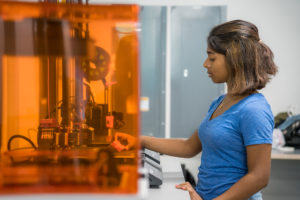The Nancy Richardson Design Center is one of the most exciting spaces on campus for collaborators and creatives who want a hands-on experience with technology in a state-of-the-art makerspace. Now, any student, faculty, or staff interested in woodworking, metal fabrication, crafting, or design can access five labs equipped with top-of-the-line machinery and materials through the new Nancy Richardson Design Center (RDC) Lab Access Membership program.
Paul Callahan, RDC fabrication labs coordinator, is thrilled about what this membership will allow users to create.
“The exciting thing about being able to offer the membership access is that it will give any CSU person access to all of our amazing resources, training, and equipment,” Callahan said. “This obviously aligns very well with the RDC mission and the Design Thinking curriculum- bringing together people from different areas of CSU for collaborative projects. There is amazing potential for problem solving, and innovation in teams with diversity of approach.”

What the membership offers
For $130 per semester, members have access to the RDC’s five labs: wood, metal, prototype, imaging, and ideation. However, any student enrolled in a class with an established RDC course fee does not have to pay for the membership fee because they already have access to all the benefits.
The metal and wood labs provide all the machines and hand tools for creating virtually anything out of their respective materials, as well as the personal protective equipment needed to operate in the lab. There are currently new machines being set up in the metal lab, and the RDC staff is hoping to allow access to that space around the middle of the semester.
The prototype lab provides access to cutting edge fabric processing equipment, including a Melco embroidery machine capable of sewing 1500 stitches per minute, as well as four 3D printers, three laser cutters, a UV printer that can print on nearly any material, and four different kinds of ink printers.
The imaging lab provides screen printing where one can design imaginative posters, clothing, ceramic tiles, school supplies, and more.
The ideation lab offers a physical and a virtual space for interdisciplinary creative thinking, with materials ranging from sticky notes and markers to the room scale virtual reality system: the HTC Vive Pro.
Membership training
As well as offering the equipment, materials, and safety gear required to operate the tools in the RDC, the membership provides the training necessary to gain a comprehensive understanding of these tools.
There are several different choices available to members looking for lab training.
“One way to get a very thorough, immersive training on our equipment is to take one of the ‘toolbox courses’ that are a part of the Design Thinking certificate,” said Callahan. “These classes focus on specific materials, processes, and software and offer a more guided approach to learning about our tools. The course offerings can be found in the course catalog under the prefix IDEA.”
Find out how to enroll in a toolbox course and learn more about a Design Thinking certificate or minor at the RDC Courses page.
Another way to complete training without taking a toolbox course is to take advantage of the in-person training sessions offered at the RDC, as well as online videos that are accessed through their Canvas page. For certain equipment, like the embroidery and long-arm quilting machines, students have the option to request an in-person training session in groups of five or more.
The wood lab training takes about three hours to complete and is currently in-person, but soon will be offered through online videos available on the RDC Canvas page.
Once the metal lab is open, the online and in-person metal lab training is also expected to take about three hours.
The orientation training module for the prototype lab is offered on the labs Canvas page and takes several minutes to complete, while the imaging lab has an available in-person training. The ideation lab requires no training, but the lab user must supply their own digital 3D model or app for the VR headset.
Membership details
Most RDC equipment must be reserved prior to use. Reservations can be made up to 14 days in advance on the RDC website’s Make page.
To find more specific details about the lab access membership, check out the membership breakdown page.

There are some limitations on specific machines, but users are able to pay for overage to continue using the equipment. The overage costs are kept to a minimum because they only cover the maintenance and consumables for the equipment. For nearly all of the machines available, the only components the user must provide are the materials to be altered and an imagination.
“The access membership will allow us to maintain and replace our equipment as needed, and offer access,” he said. “This ensures that future generations of CSU students, faculty, and staff can have access to the same amazing technology.”
Find out more about the RDC Membership Program on the RDC website.
The Nancy Richardson Design Center is an interdisciplinary program in CSU’s College of Health and Human Sciences.